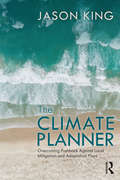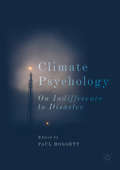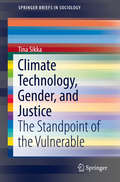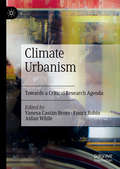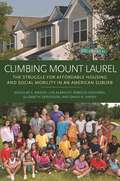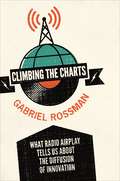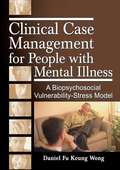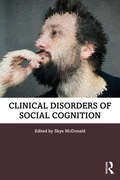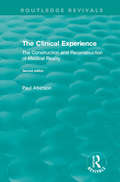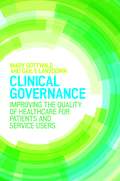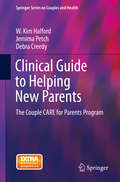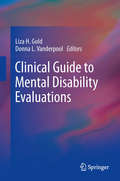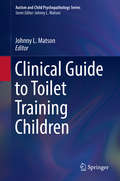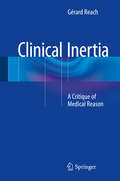- Table View
- List View
The Climate Planner: Overcoming Pushback Against Local Mitigation and Adaptation Plans
by Jason KingThe Climate Planner is about overcoming the objections to climate change mitigation and adaption that urban planners face at a local level. It shows how to draft climate plans that encounter less resistance because they involve the public, stakeholders, and decisionmakers in a way that builds trust, creates consensus, and leads to implementation. Although focused on the local level, this book discusses climate basics such as carbon dioxide levels in the atmosphere, the Intergovernmental Panel on Climate Change, the Paris Agreement of 2015, worldwide energy generation forecasts, and other items of global concern in order to familiarize urban planners and citizen planners with key concepts that they will need to know in order to be able to host climate conversations at the local level. The many case studies from around the United States of America show how communities have encountered pushback and bridged the implementation gap, the gap between plan and reality, thanks to a commitment to substantive public engagement. The book is written for urban planners, local activists, journalists, elected or appointed representatives, and the average citizen worried about climate breakdown and interested in working to reshape the built environment.
The Climate Planner: Overcoming Pushback Against Local Mitigation and Adaptation Plans
by Jason KingThe Climate Planner is about overcoming the objections to climate change mitigation and adaption that urban planners face at a local level. It shows how to draft climate plans that encounter less resistance because they involve the public, stakeholders, and decisionmakers in a way that builds trust, creates consensus, and leads to implementation. Although focused on the local level, this book discusses climate basics such as carbon dioxide levels in the atmosphere, the Intergovernmental Panel on Climate Change, the Paris Agreement of 2015, worldwide energy generation forecasts, and other items of global concern in order to familiarize urban planners and citizen planners with key concepts that they will need to know in order to be able to host climate conversations at the local level. The many case studies from around the United States of America show how communities have encountered pushback and bridged the implementation gap, the gap between plan and reality, thanks to a commitment to substantive public engagement. The book is written for urban planners, local activists, journalists, elected or appointed representatives, and the average citizen worried about climate breakdown and interested in working to reshape the built environment.
Climate Positive Business: How You and Your Company Hit Bold Climate Goals and Go Net Zero
by David JaberThis is the decade for climate action. Internal and external stakeholders demand action. How we choose to act in the next ten years will determine our foreseeable future. Businesses hold a critical role for climate futures. The need for businesses to reduce their carbon footprint is now unquestioned, but how to achieve reductions in a credible way is neither clear nor easy once you’ve tackled the obvious energy culprits. Climate Positive Business lays out the path of business climate strategy, highlighting how your business must set goals, measure impact, and improve performance. Greenhouse gas protocols can instruct you on the core accounting process that lies at the heart of climate strategy. At least as important to success are the details that protocols don’t tell you: the sticking points; the areas of controversy, and the best practices. Rooted in real experience and written in an entertaining and engaging style, this book provides you with the tips, tools, and techniques to tackle your company’s carbon footprint, and it helps you do so in a way that is credible and appropriately ambitious to meet stakeholder expectations. The book will equip you with tools to think critically about GHG reduction, carbon offsets, and carbon removal, as well as help ensure we collectively implement real solutions to slow and eventually reverse the climate crisis. It includes lessons learned from real-world consulting projects and provides a plan of action for readers to implement. A go-to book for business looking to understand, manage, and reduce their carbon footprint, it is an invaluable resource for sustainable business practitioners, consultants, and those aspiring to become climate champions.
Climate Positive Business: How You and Your Company Hit Bold Climate Goals and Go Net Zero
by David JaberThis is the decade for climate action. Internal and external stakeholders demand action. How we choose to act in the next ten years will determine our foreseeable future. Businesses hold a critical role for climate futures. The need for businesses to reduce their carbon footprint is now unquestioned, but how to achieve reductions in a credible way is neither clear nor easy once you’ve tackled the obvious energy culprits. Climate Positive Business lays out the path of business climate strategy, highlighting how your business must set goals, measure impact, and improve performance. Greenhouse gas protocols can instruct you on the core accounting process that lies at the heart of climate strategy. At least as important to success are the details that protocols don’t tell you: the sticking points; the areas of controversy, and the best practices. Rooted in real experience and written in an entertaining and engaging style, this book provides you with the tips, tools, and techniques to tackle your company’s carbon footprint, and it helps you do so in a way that is credible and appropriately ambitious to meet stakeholder expectations. The book will equip you with tools to think critically about GHG reduction, carbon offsets, and carbon removal, as well as help ensure we collectively implement real solutions to slow and eventually reverse the climate crisis. It includes lessons learned from real-world consulting projects and provides a plan of action for readers to implement. A go-to book for business looking to understand, manage, and reduce their carbon footprint, it is an invaluable resource for sustainable business practitioners, consultants, and those aspiring to become climate champions.
Climate Protection, Resource Efficiency, and Sustainable Engineering: Transdisciplinary Approaches to Design and Manufacturing Technology (Science Studies)
by Ilona Horwath Swetlana SchweizerThe big societal challenges, such as climate change and public health, call for innovative approaches to address them. The contributors of this book present new ways to tackle these challenges by inter- and transdisciplinary collaborations in light weight engineering. They introduce a framework for transdisciplinary collaboration, explore the potential of light weight engineering in the areas of climate protection, resource efficiency, and sustainable mobility. To do so, they exemplify results and limitations of transdisciplinary collaboration based on three case studies: the optimization of rescue tools, the re-design of products to foster re-use and recycling processes in companies and society, and the additive manufacturing of individualized assistive tools and prostheses.
Climate Psychology: On Indifference to Disaster (Studies in the Psychosocial)
by Paul HoggettThis book investigates the psycho-social phenomenon which is society’s failure to respond to climate change. It analyses the non-rational dimensions of our collective paralysis in the face of worsening climate change and environmental destruction, exploring the emotional, ethical, social, organizational and cultural dynamics to blame for this global lack of action. The book features eleven research projects from four different countries and is divided in two parts, the first highlighting novel methodologies, the second presenting new findings. Contributors to the first part show how a ‘deep listening’ approach to research can reveal the anxieties, tensions, contradictions, frames and narratives that contribute to people’s experiences, and the many ways climate change and other environmental risks are imagined through metaphor, imagery and dreams. Using detailed interview extracts drawn from politicians, scientists and activists as well as ordinary people, the second part of the book examines the many different ways in which we both avoid and square up to this gathering disaster, and the many faces of alarm, outrage, denial and indifference this involves.
Climate Technology, Gender, and Justice: The Standpoint Of The Vulnerable (Springerbriefs In Sociology Ser.)
by Tina SikkaThis book is the first to undertake a gendered analysis of geoengineering and alternative energy sources. Are either of these technologies sufficiently attendant to gender issues? Do they incorporate feminist values as articulated by the renowned social philosopher Helen Longino, such as empirical adequacy, novelty, heterogeneity, complexity and applicability to human needs? The overarching argument in this book contends that, while mitigation strategies like solar and wind energy go much further to meet feminist objectives and virtues, geoengineering is not consistent with the values of justice as articulated in Longino's feminist approach to science. This book provides a novel, feminist argument in support of pursuing alternative energy in the place of geoengineering. It provides an invaluable contribution for academics and students working in the areas of gender, science and climate change as well as policy makers interested in innovative ways of taking up climate change mitigation and gender.
Climate Urbanism: Towards a Critical Research Agenda
by Vanesa Castán Broto Enora Robin Aidan WhileThis book argues that the relationship between cities and climate change is entering a new and more urgent phase. Thirteen contributions from a range of leading scholars explore the need to rethink and reorient urban life in response to climatic change. Split into four parts it begins by asking ‘What is climate urbanism?’ and exploring key features from different locations and epistemological traditions. The second section examines the transformative potential of climate urbanism to challenge social and environmental injustices within and between cities. In the third part authors interrogate current knowledge paradigms underpinning climate and urban science and how they shape contemporary urban trajectories. The final section focuses on the future, envisaging climate urbanism as a new communal project, and focuses on the role of citizens and non-state actors in driving transformative action. Consolidating debates on climate urbanism, the book highlights the opportunities and tensions of urban environmental policy, providing a framework for researchers and practitioners to respond to the urban challenges of a radically climate-changed world.
Climbing Mount Laurel: The Struggle for Affordable Housing and Social Mobility in an American Suburb
by Douglas S. Massey Len Albright Rebecca Casciano Elizabeth Derickson David N. KinseyUnder the New Jersey State Constitution as interpreted by the State Supreme Court in 1975 and 1983, municipalities are required to use their zoning authority to create realistic opportunities for a fair share of affordable housing for low- and moderate-income households. Mount Laurel was the town at the center of the court decisions. As a result, Mount Laurel has become synonymous with the debate over affordable housing policy designed to create economically integrated communities. What was the impact of the Mount Laurel decision on those most affected by it? What does the case tell us about economic inequality?Climbing Mount Laurel undertakes a systematic evaluation of the Ethel Lawrence Homes--a housing development produced as a result of the Mount Laurel decision. Douglas Massey and his colleagues assess the consequences for the surrounding neighborhoods and their inhabitants, the township of Mount Laurel, and the residents of the Ethel Lawrence Homes. Their analysis reveals what social scientists call neighborhood effects--the notion that neighborhoods can shape the life trajectories of their inhabitants. Climbing Mount Laurel proves that the building of affordable housing projects is an efficacious, cost-effective approach to integration and improving the lives of the poor, with reasonable cost and no drawbacks for the community at large.
Climbing Mount Laurel: The Struggle for Affordable Housing and Social Mobility in an American Suburb (PDF)
by Douglas S. Massey Len Albright Rebecca Casciano Elizabeth Derickson David N. KinseyUnder the New Jersey State Constitution as interpreted by the State Supreme Court in 1975 and 1983, municipalities are required to use their zoning authority to create realistic opportunities for a fair share of affordable housing for low- and moderate-income households. Mount Laurel was the town at the center of the court decisions. As a result, Mount Laurel has become synonymous with the debate over affordable housing policy designed to create economically integrated communities. What was the impact of the Mount Laurel decision on those most affected by it? What does the case tell us about economic inequality?Climbing Mount Laurel undertakes a systematic evaluation of the Ethel Lawrence Homes--a housing development produced as a result of the Mount Laurel decision. Douglas Massey and his colleagues assess the consequences for the surrounding neighborhoods and their inhabitants, the township of Mount Laurel, and the residents of the Ethel Lawrence Homes. Their analysis reveals what social scientists call neighborhood effects--the notion that neighborhoods can shape the life trajectories of their inhabitants. Climbing Mount Laurel proves that the building of affordable housing projects is an efficacious, cost-effective approach to integration and improving the lives of the poor, with reasonable cost and no drawbacks for the community at large.
Climbing the Charts: What Radio Airplay Tells Us about the Diffusion of Innovation
by Gabriel RossmanDespite the growth of digital media, traditional FM radio airplay still remains the essential way for musicians to achieve commercial success. Climbing the Charts examines how songs rise, or fail to rise, up the radio airplay charts. Looking at the relationships between record labels, tastemakers, and the public, Gabriel Rossman develops a clear picture of the roles of key players and the gatekeeping mechanisms in the commercial music industry. Along the way, he explores its massive inequalities, debunks many popular misconceptions about radio stations' abilities to dictate hits, and shows how a song diffuses throughout the nation to become a massive success. Contrary to the common belief that Clear Channel sees every sparrow that falls, Rossman demonstrates that corporate radio chains neither micromanage the routine decision of when to start playing a new single nor make top-down decisions to blacklist such politically inconvenient artists as the Dixie Chicks. Neither do stations imitate either ordinary peers or the so-called kingmaker radio stations who are wrongly believed to be able to make or break a single. Instead, Rossman shows that hits spread rapidly across radio because they clearly conform to an identifiable style or genre. Radio stations respond to these songs, and major labels put their money behind them through extensive marketing and promotion efforts, including the illegal yet time-honored practice of payoffs known within the industry as payola. Climbing the Charts provides a fresh take on the music industry and a model for understanding the diffusion of innovation.
Climbing the Charts: What Radio Airplay Tells Us about the Diffusion of Innovation (PDF)
by Gabriel RossmanDespite the growth of digital media, traditional FM radio airplay still remains the essential way for musicians to achieve commercial success. Climbing the Charts examines how songs rise, or fail to rise, up the radio airplay charts. Looking at the relationships between record labels, tastemakers, and the public, Gabriel Rossman develops a clear picture of the roles of key players and the gatekeeping mechanisms in the commercial music industry. Along the way, he explores its massive inequalities, debunks many popular misconceptions about radio stations' abilities to dictate hits, and shows how a song diffuses throughout the nation to become a massive success. Contrary to the common belief that Clear Channel sees every sparrow that falls, Rossman demonstrates that corporate radio chains neither micromanage the routine decision of when to start playing a new single nor make top-down decisions to blacklist such politically inconvenient artists as the Dixie Chicks. Neither do stations imitate either ordinary peers or the so-called kingmaker radio stations who are wrongly believed to be able to make or break a single. Instead, Rossman shows that hits spread rapidly across radio because they clearly conform to an identifiable style or genre. Radio stations respond to these songs, and major labels put their money behind them through extensive marketing and promotion efforts, including the illegal yet time-honored practice of payoffs known within the industry as payola. Climbing the Charts provides a fresh take on the music industry and a model for understanding the diffusion of innovation.
Clinical Applications of Linguistics to Speech-Language Pathology: A Guide for Clinicians
by Naomi Gurevich Christopher M. GrindrodClinical Applications of Linguistics to Speech-Language Pathology is a practical guide that provides linguistically grounded approaches to clinical practice. It introduces key linguistic disciplines and discusses how they form a basis for assessment and treatment of individuals with communication differences or disorders. Written by experts in linguistics and communication disorders, each chapter provides clinicians with a foundational understanding of linguistics as it applies to spoken and signed languages and underscores the importance of integrating linguistic theories into clinical decision-making. The book is divided into two parts that focus on the applications of linguistics to speech and language differences and disorders in both children and adults. The chapters cover the full range of linguistic domains including phonetics, phonology, morphology, syntax, semantics, pragmatics, and sociolinguistics. Applications to a wide range of populations including childhood apraxia of speech, aphasia, dysarthria, traumatic brain injury and accent modification clients are also discussed. Many chapters include assessment and treatment resources that can be used by practicing clinicians. This highly accessible and comprehensive book is an indispensable resource for practicing speech-language pathologists and other members of the profession, including instructors with minimal exposure to linguistics. It will also be beneficial for students of Linguistics, Speech and Hearing Sciences, and Audiology and Speech Language Pathology who are seeking practical knowledge of the fields.
Clinical Applications of Linguistics to Speech-Language Pathology: A Guide for Clinicians
by Naomi Gurevich Christopher M. GrindrodClinical Applications of Linguistics to Speech-Language Pathology is a practical guide that provides linguistically grounded approaches to clinical practice. It introduces key linguistic disciplines and discusses how they form a basis for assessment and treatment of individuals with communication differences or disorders. Written by experts in linguistics and communication disorders, each chapter provides clinicians with a foundational understanding of linguistics as it applies to spoken and signed languages and underscores the importance of integrating linguistic theories into clinical decision-making. The book is divided into two parts that focus on the applications of linguistics to speech and language differences and disorders in both children and adults. The chapters cover the full range of linguistic domains including phonetics, phonology, morphology, syntax, semantics, pragmatics, and sociolinguistics. Applications to a wide range of populations including childhood apraxia of speech, aphasia, dysarthria, traumatic brain injury and accent modification clients are also discussed. Many chapters include assessment and treatment resources that can be used by practicing clinicians. This highly accessible and comprehensive book is an indispensable resource for practicing speech-language pathologists and other members of the profession, including instructors with minimal exposure to linguistics. It will also be beneficial for students of Linguistics, Speech and Hearing Sciences, and Audiology and Speech Language Pathology who are seeking practical knowledge of the fields.
Clinical Case Management for People with Mental Illness: A Biopsychosocial Vulnerability-Stress Model
by Daniel Fu WongA unique-and effective-approach to mental health practiceClinical Case Management for People with Mental Illness combines theory, practice, and plenty of clinical examples to introduce a unique approach to case management that&’s based on a biopsychosocial vulnerability-stress model. This practice-oriented handbook stresses the dynamic interplay among biological, psychological, social, and environmental factors that influences the development-and severity-of a person&’s mental illness. Filled with case examples to illustrate the assessment and intervention process, the book is an essential resource for working with people who suffer from depression, anxiety disorders, schizophrenia, and personality disorders.Author Daniel Fu Keung Wong draws on his experiences as an educator, cognitive therapist, mental health worker, and case manager working in Asia and Australia to explore the concepts and contexts of clinical case management for individuals suffering from mild and chronic mental illness. He guides you through the creative use of various therapeutic approaches that emphasize different aspects of a person&’s condition that can influence the cause and course of mental illness. Clinical Case Management for People with Mental Illness examines a range of important topics, including the roles and functions of mental health workers, relapse prevention, assessment and clinical intervention, psychiatric crisis management, and working with families. In addition, the book includes checklists, worksheets, activity charts, and three helpful appendices. Clinical Case Management for People with Mental Illness examines: models of assessment microskills in assessment areas of assessment and intervention understanding the roles and psychological reactions of family members assessing and working with individuals with suicidal risk or aggressive behaviors and much more!Clinical Case Management for People with Mental Illness is an essential resource for mental health professionals, including psychologists, occupational therapists, mental health social workers, nurses, counselors, and family social workers.
Clinical Case Management for People with Mental Illness: A Biopsychosocial Vulnerability-Stress Model
by Daniel Fu WongA unique-and effective-approach to mental health practiceClinical Case Management for People with Mental Illness combines theory, practice, and plenty of clinical examples to introduce a unique approach to case management that&’s based on a biopsychosocial vulnerability-stress model. This practice-oriented handbook stresses the dynamic interplay among biological, psychological, social, and environmental factors that influences the development-and severity-of a person&’s mental illness. Filled with case examples to illustrate the assessment and intervention process, the book is an essential resource for working with people who suffer from depression, anxiety disorders, schizophrenia, and personality disorders.Author Daniel Fu Keung Wong draws on his experiences as an educator, cognitive therapist, mental health worker, and case manager working in Asia and Australia to explore the concepts and contexts of clinical case management for individuals suffering from mild and chronic mental illness. He guides you through the creative use of various therapeutic approaches that emphasize different aspects of a person&’s condition that can influence the cause and course of mental illness. Clinical Case Management for People with Mental Illness examines a range of important topics, including the roles and functions of mental health workers, relapse prevention, assessment and clinical intervention, psychiatric crisis management, and working with families. In addition, the book includes checklists, worksheets, activity charts, and three helpful appendices. Clinical Case Management for People with Mental Illness examines: models of assessment microskills in assessment areas of assessment and intervention understanding the roles and psychological reactions of family members assessing and working with individuals with suicidal risk or aggressive behaviors and much more!Clinical Case Management for People with Mental Illness is an essential resource for mental health professionals, including psychologists, occupational therapists, mental health social workers, nurses, counselors, and family social workers.
Clinical Disorders of Social Cognition
by Skye McDonaldClinical Disorders of Social Cognition provides contemporary neuroscientific theories of social cognition in a wide range of conditions across the lifespan. Taking a trans-diagnostic approach to understanding these disorders, it discusses how they present in different conditions, ranging from brain injury to neurodevelopmental disorders, psychiatric conditions and dementia. Social cognitive disorders directly impact upon individuals’ work, leisure and social functioning. This book also collates and critiques the best and most useful assessment tools across the different disorders and coalesces research into intervention strategies across disorders to provide practical information about how such disorders can be assessed and treated so individuals can have meaningful, effective and satisfying social interactions. This book is essential reading for clinicians who work with people with clinical disorders and who are looking for new knowledge to understand, assess and treat their clients with social cognitive impairment. It will also appeal to students and professionals in clinical neuropsychology, speech and language pathology and researchers who are interested in learning more about the social brain and understanding how evidence from clinical conditions can inform this.
Clinical Disorders of Social Cognition
by Skye McDonaldClinical Disorders of Social Cognition provides contemporary neuroscientific theories of social cognition in a wide range of conditions across the lifespan. Taking a trans-diagnostic approach to understanding these disorders, it discusses how they present in different conditions, ranging from brain injury to neurodevelopmental disorders, psychiatric conditions and dementia. Social cognitive disorders directly impact upon individuals’ work, leisure and social functioning. This book also collates and critiques the best and most useful assessment tools across the different disorders and coalesces research into intervention strategies across disorders to provide practical information about how such disorders can be assessed and treated so individuals can have meaningful, effective and satisfying social interactions. This book is essential reading for clinicians who work with people with clinical disorders and who are looking for new knowledge to understand, assess and treat their clients with social cognitive impairment. It will also appeal to students and professionals in clinical neuropsychology, speech and language pathology and researchers who are interested in learning more about the social brain and understanding how evidence from clinical conditions can inform this.
The Clinical Experience, Second edition: The Construction and Reconstrucion of Medical Reality (Routledge Revivals)
by Paul AtkinsonThis second edition, published in 1997 follows the original edition from 1981 which was the only published ethnography of medical education in the UK. The theoretical, methodological and substantive issues continue to be of importance to the sociology and anthropology of medicine and medical knowledge. Indeed, critiques of contemporary ‘biomedicine’ and the growing interest in the sociology of the body have made its central concerns of even greater significance than when the first edition was published. Covering topics including the clinical tradition, the social distribution of bedside knowledge, reproducing disease, and the clinical setting, this expanded edition builds on the success of the first and will interest researchers and clinicians in the fields of sociology, anthropology and medicine. This book was originally published as part of the Cardiff Papers in Qualitative Research series edited by Paul Atkinson, Sara Delamont and Amanda Coffey. The series publishes original sociological research that reflects the tradition of qualitative and ethnographic inquiry developed at Cardiff. The series includes monographs reporting on empirical research, edited collections focussing on particular themes, and texts discussing methodological developments and issues.
The Clinical Experience, Second edition: The Construction and Reconstrucion of Medical Reality (Routledge Revivals)
by Paul AtkinsonThis second edition, published in 1997 follows the original edition from 1981 which was the only published ethnography of medical education in the UK. The theoretical, methodological and substantive issues continue to be of importance to the sociology and anthropology of medicine and medical knowledge. Indeed, critiques of contemporary ‘biomedicine’ and the growing interest in the sociology of the body have made its central concerns of even greater significance than when the first edition was published. Covering topics including the clinical tradition, the social distribution of bedside knowledge, reproducing disease, and the clinical setting, this expanded edition builds on the success of the first and will interest researchers and clinicians in the fields of sociology, anthropology and medicine. This book was originally published as part of the Cardiff Papers in Qualitative Research series edited by Paul Atkinson, Sara Delamont and Amanda Coffey. The series publishes original sociological research that reflects the tradition of qualitative and ethnographic inquiry developed at Cardiff. The series includes monographs reporting on empirical research, edited collections focussing on particular themes, and texts discussing methodological developments and issues.
Clinical Governance: Improving The Quality Of Healthcare For Patients And Service Users (UK Higher Education OUP Humanities & Social Sciences Health & Social Welfare)
by Mary Gottwald Gail LansdownThis new text is an accessible and practical guide to clinical governance in healthcare, designed to help practitioners and students deliver quality care to patients and improve the patient experience at every level. Grounded in the application of clinical governance, it explains in detail what it looks like in practice. Using common examples of clinical governance challenges, this book gives real and practical insights into how individuals can contribute to clinical governance in a range of healthcare settings. Each chapter includes case studies, reflective activities, tips and real experiences to help readers apply the theory to practice, and identify areas in which they can improve the patient experience. This is key reading for all healthcare practitioners."In this excellent new book on clinical Governance, Mary Gottwald and Gail Lansdown distil down what this complex topic encompasses. They put bones on the individual components and lead the reader easily through the topic, so that he or she ends up with a good understanding of how the system is supposed to function and their individual responsibilities as a clinician, academic, trainer or manager ... I wish that I had been able to read a book such as this when I started off. It would have saved me a lot of time and trouble getting my head around all the aspects of this vital topic. Providing a reliable, safe, high quality service is the major challenge for all of us working in health services, so this fine book is very welcome."Dr Peter Featherstone MPhil, FRCP, Lead for Clinical Governance in Acute MedicineConsultant Physician and Honorary Medical Senior Lecturer Portsmouth Hospitals NHS Trust"The book has been developed for pre- and post - registration students, but it will appeal to a wider audience, particularly those who want more knowledge of Governance and its antecedents. The outline of Chapters at the start helpfully leads the reader the appropriate section, and within each section the authors attempt to link clinical governance theory to practical examples. This is further emphasised by the use of reflective questions at the end of each chapter. The chapter on Clinical Audit is excellent, and is of use to anyone including medical staff in terms of how Clinical Audits should be conducted.It is an excellent, easy read journey through all aspects of Clinical Governance and its application to patient experience, safety and effective senses, ultimately quality of care."Sharon Linter, Director of Quality and Governance/ Executive Nurse, Cornwall Partnership NHS Foundation Trust
Clinical Guide to Helping New Parents: The Couple CARE for Parents Program (Springer Series on Couples and Health)
by W. Kim Halford Jemima Petch Debra CreedyThis accessible guide details an evidence-based educational program to help couples adapt to parenthood while minimizing the inevitable stress on the relationship. Complete with content, rationales, activities, and client materials, its flexible format allows for home and office visits and phone/online support across the transition, starting during pregnancy and continuing into early infancy. Activities build on themes of caring, change, and cooperation as couples learn to identify and address sources of conflict, solve infant-care problems, and to become optimal partners as well as optimal parents. The book's hands-on presentation includes chapter highlights, boxed "Practice Tips" and "Clinical Connections" sections, client handouts and worksheets, and examples of clinician interactions with couples.The sessions described in Clinical Guide to Helping New Parents: The Couple CARE for Parents Program are organized to meet challenges and reinforce skills in key areas including:Developing realistic and shared expectations.Promoting positive communications and self-change.Conflict management communication skills.Developing sensitive and responsive parenting Reviewing personal and social support.Developing caring and healthy sexuality.Anticipating and preventing relationship deterioration.
Clinical Guide to Mental Disability Evaluations
by Liza H. Gold and Donna L. VanderpoolDisability evaluations are the most common clinical mental health evaluations conducted for nontreatment purposes. They place mental health professionals in the role of communicating information that is typically confidential to administrative and legal systems. Unfortunately, mental health professionals receive little to no training in conducting assessments that focus on disability and disability management, and often do not understand the implications and risks of providing this information, especially without conducting what are often specialized evaluations. Clinical Guide to Mental Health Disability Evaluations is geared for general mental health practitioners, providing them with the basic information needed to competently provide the various types of disability evaluations. It also provides enough information to inform forensic mental health providers in conducting more specialized evaluations.
Clinical Guide to Toilet Training Children (Autism and Child Psychopathology Series)
by Johnny L. MatsonThis book offers a comprehensive overview of the universal issue of toilet training in children and explores issues that need to be considered by clinicians and other professionals. The book begins with a historical overview of the field, including origins and reviews of current practices. It discusses various toileting problems and their side effects, risk factors, normal developmental milestones in toileting, and theories of toileting. Chapters identify behavior problems (e.g., self-injury, noncompliance) as well as medical conditions (e.g., diabetes, constipation) that can affect continence, with proven strategies for addressing these challenges in toilet training children, including those with intellectual and developmental disabilities. The book concludes with a discussion of the strengths of current toilet training practices as well as suggestions for areas where continued improvement is required.Topics featured in this book include:· Complications and side effects associated with the lack of toileting skills.· Technology used in toilet training.· Applications of operant-based behavioral principles to toilet training.· Toilet training strategies involving modeling and modifications of the physical environment.· Toilet training children with physical disabilities. The Clinical Guide to Toilet Training Children is a must-have resource for researchers, graduate students, clinicians, and related therapists and professionals in clinical child and school psychology, pediatrics, family studies, developmental psychology, nursing, social work, and behavioral therapy/rehabilitation.
Clinical Inertia: A Critique of Medical Reason
by Gérard ReachClinical practice guidelines were initially developed within the context of evidence-based medicine with the goal of putting medical research findings into practice. However, physicians do not always follow them, even when they seem to apply to the particular patient they have to treat. This phenomenon, known as clinical inertia, represents a significant obstacle to the efficiency of care and a major public health problem, the extent of which is demonstrated in this book.An analysis of its causes shows that it stems from a discrepancy between the objective, essentially statistical nature of evidence-based medicine on the one hand and the physician’s own complex, subjective view (referred to here as “medical reason”) on the other. This book proposes a critique of medical reason that may help to reconcile the principles of evidence-based medicine and individual practice.The author is a diabetologist and Professor of Endocrinology, Diabetology and Metabolic Diseases at Paris 13 University. He has authored several books, including one to be published by Springer (Philosophy and Medicine series) under the title: The Mental Mechanisms of Patient Adherence to Long Term Therapies, Mind and Care., Diabetology and Metabolic Diseases at the Paris 13-University. He has also published Pourquoi Se soigne-t-on, Enquête sur la rationalité morale de l’observance (2007), Clinique de l’Observance, L’Exemple des diabètes (2006), and Une théorie du soin, Souci et amour face à la maladie (2010). An English adaptation of the first book is published by Springer (Philosophy and Medicine) under the title: The Mental Mechanisms of Patient Adherence to Long Term Therapies, Mind and Care.
